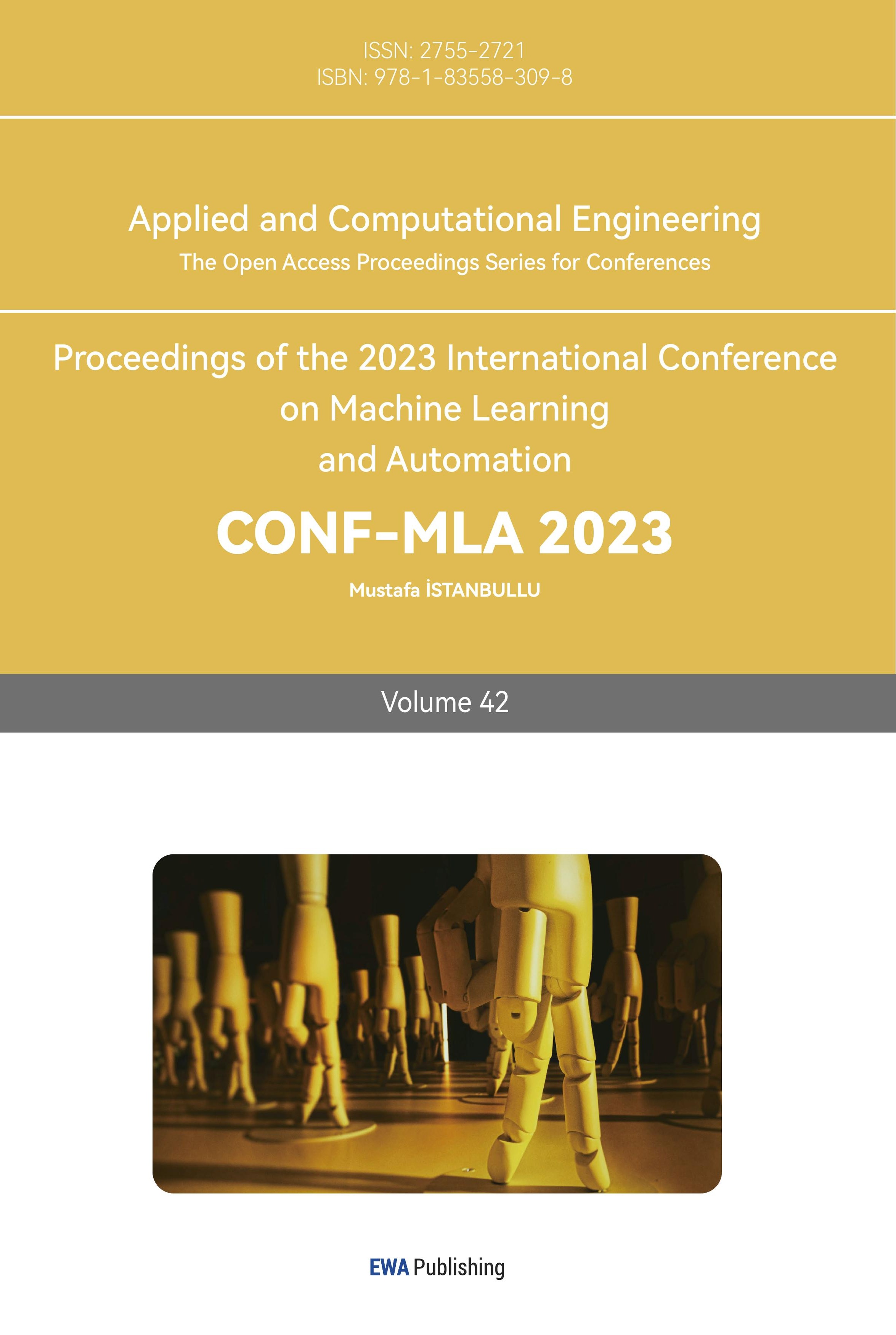References
[1]. Zhang Cheng. "Preparation and application of flexible wearable electronic skin based on nanotechnology [D]". Engineering Technology Part I; Information Technology, 2022
[2]. Niu, H. et al."‘Perception-to-Cognition Tactile Sensing Based on Artificial-Intelligence-Motivated Human Full-Skin Bionic Electronic Skin" Advanced Materials, Aug. 2022
[3]. H.Chen, L.Dajace, SP.Lacour. “Electronic Skins for Healthcare Monitoring and Smart Prostheses.” Annual Review of Control, Robotics, and Autonomous Systems, vol. 4, pp. 629–650, May 2021
[4]. W.Wang, Y.Jiang, et al. “Neuromorphic Sensorimotor Loop Embodied by Monolithically Integrated, Low-Voltage, Soft E-Skin.” Science, vol. 380, pp. 735–742, May 2023.
[5]. J.Cui, D.Daniel, A.Grinthal, K.Lin, J.Aizenberg. “Dynamic Polymer Systems with Self-Regulated Secretion for the Control of Surface Properties and Material Healing.” Nature Materials, vol. 14, pp. 790–795, Jun. 2015.
[6]. S.Yin, G.Su, J.Chen, X.Peng, T.Zhou. “Ultra-Stretchable and Self-Healing Anti-Freezing Strain Sensors Based on Hydrophobic Associated Polyacrylic Acid Hydrogels.” Materials, vol. 14, pp. 6165-6165, Oct. 2021.
[7]. Korzynski P, Kozminski AK, Baczynska A. “Navigating leadership challenges with technology: Uncovering the potential of ChatGPT, virtual reality, human capital management systems, robotic process automation, and social media." International Entrepreneurship Review, Vol. 9, pp. 7-18. Sep. 2023
[8]. Beom Jun Jo, Seok-Kyoo Kim and SeongKi Kim "Enhancing Virtual and Augmented Reality Interactions with a MediaPipe-Based Hand Gesture Recognition User Interface", Ingénierie des Systèmes d’Information, vol. 28, pp. 633-638. Jun. 2022
[9]. Yao H, Chiam JS, Tee BCK, et al. "Augmented Reality Interfaces Using Virtual Customization of Microstructured Electronic Skin Sensor Sensitivity Performances." Advanced Functional Materials. Vol. 31, pp. 1-10. Sep. 2023
[10]. Y. Liu et al., "Skin-Integrated Haptic Interfaces Enabled by Scalable Mechanical Actuators for Virtual Reality," in IEEE Internet of Things Journal, vol. 10, pp. 653-663, Jan. 2023
Cite this article
Gao,X.;Li,T.;Yu,X.;Liu,M.;Sheng,H. (2024). Research on electronic skin in artificial intelligence, smart medicine, virtual reality. Applied and Computational Engineering,42,195-200.
Data availability
The datasets used and/or analyzed during the current study will be available from the authors upon reasonable request.
Disclaimer/Publisher's Note
The statements, opinions and data contained in all publications are solely those of the individual author(s) and contributor(s) and not of EWA Publishing and/or the editor(s). EWA Publishing and/or the editor(s) disclaim responsibility for any injury to people or property resulting from any ideas, methods, instructions or products referred to in the content.
About volume
Volume title: Proceedings of the 2023 International Conference on Machine Learning and Automation
© 2024 by the author(s). Licensee EWA Publishing, Oxford, UK. This article is an open access article distributed under the terms and
conditions of the Creative Commons Attribution (CC BY) license. Authors who
publish this series agree to the following terms:
1. Authors retain copyright and grant the series right of first publication with the work simultaneously licensed under a Creative Commons
Attribution License that allows others to share the work with an acknowledgment of the work's authorship and initial publication in this
series.
2. Authors are able to enter into separate, additional contractual arrangements for the non-exclusive distribution of the series's published
version of the work (e.g., post it to an institutional repository or publish it in a book), with an acknowledgment of its initial
publication in this series.
3. Authors are permitted and encouraged to post their work online (e.g., in institutional repositories or on their website) prior to and
during the submission process, as it can lead to productive exchanges, as well as earlier and greater citation of published work (See
Open access policy for details).
References
[1]. Zhang Cheng. "Preparation and application of flexible wearable electronic skin based on nanotechnology [D]". Engineering Technology Part I; Information Technology, 2022
[2]. Niu, H. et al."‘Perception-to-Cognition Tactile Sensing Based on Artificial-Intelligence-Motivated Human Full-Skin Bionic Electronic Skin" Advanced Materials, Aug. 2022
[3]. H.Chen, L.Dajace, SP.Lacour. “Electronic Skins for Healthcare Monitoring and Smart Prostheses.” Annual Review of Control, Robotics, and Autonomous Systems, vol. 4, pp. 629–650, May 2021
[4]. W.Wang, Y.Jiang, et al. “Neuromorphic Sensorimotor Loop Embodied by Monolithically Integrated, Low-Voltage, Soft E-Skin.” Science, vol. 380, pp. 735–742, May 2023.
[5]. J.Cui, D.Daniel, A.Grinthal, K.Lin, J.Aizenberg. “Dynamic Polymer Systems with Self-Regulated Secretion for the Control of Surface Properties and Material Healing.” Nature Materials, vol. 14, pp. 790–795, Jun. 2015.
[6]. S.Yin, G.Su, J.Chen, X.Peng, T.Zhou. “Ultra-Stretchable and Self-Healing Anti-Freezing Strain Sensors Based on Hydrophobic Associated Polyacrylic Acid Hydrogels.” Materials, vol. 14, pp. 6165-6165, Oct. 2021.
[7]. Korzynski P, Kozminski AK, Baczynska A. “Navigating leadership challenges with technology: Uncovering the potential of ChatGPT, virtual reality, human capital management systems, robotic process automation, and social media." International Entrepreneurship Review, Vol. 9, pp. 7-18. Sep. 2023
[8]. Beom Jun Jo, Seok-Kyoo Kim and SeongKi Kim "Enhancing Virtual and Augmented Reality Interactions with a MediaPipe-Based Hand Gesture Recognition User Interface", Ingénierie des Systèmes d’Information, vol. 28, pp. 633-638. Jun. 2022
[9]. Yao H, Chiam JS, Tee BCK, et al. "Augmented Reality Interfaces Using Virtual Customization of Microstructured Electronic Skin Sensor Sensitivity Performances." Advanced Functional Materials. Vol. 31, pp. 1-10. Sep. 2023
[10]. Y. Liu et al., "Skin-Integrated Haptic Interfaces Enabled by Scalable Mechanical Actuators for Virtual Reality," in IEEE Internet of Things Journal, vol. 10, pp. 653-663, Jan. 2023









